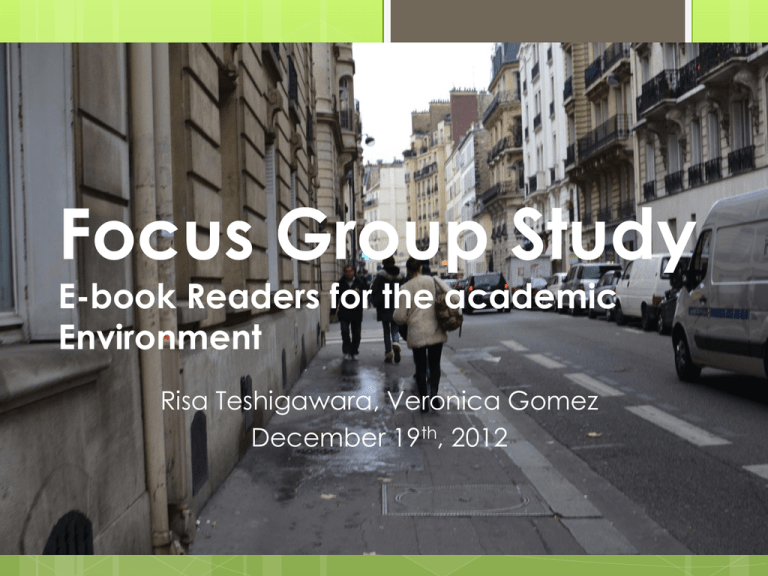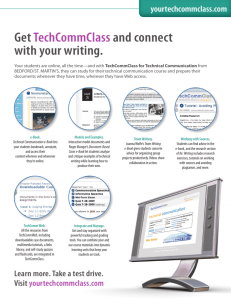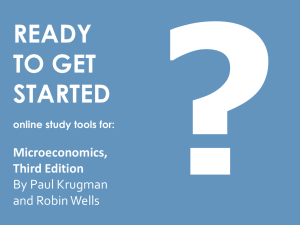Focus Group Study E-book Readers for the academic
advertisement

Focus Group Study E-book Readers for the academic Environment Risa Teshigawara, Veronica Gomez December 19th, 2012 Introduction *Pew Research Center for the People and Press Many people use e-book readers instead of carrying paper books around with them. It is rare to see university students using e-book readers for class or to study with. e-book readers appear to be used mainly leisure reading Objective of this Study To discuss how e-book readers can be improved in order to be used in academic environments To gather useful information, such as student and faculty opinions, suggestions, and ideas for e-book readers Research Questions What are the advantages and disadvantages that the use of e-book readers may provide to students? Are there hardware and/or software improvements that can be made to e-book readers to make them better suited for academic use? What functionalities should e-book readers offer to be most useful for students? Setting Place: Classroom PV-1 @ AUP Time: November 15th, 2012 15:20 – 16:40 Participants • A total of 6 participants were comprised of students and faculty. • A Computer Science professor was invited in order to provide insight from a faculty perspective • 2 Librarians attended and contributed their opinions Comparison of the two Devices SONY PRS-T2 Nexus 7 Storage Capacity 2GB 8, 16, or 32GB Display E Ink display / backlit E-ink LCD capacitive touch screen Size 173 × 110 × 9.1 mm 198.5×120×10.56 mm Weight 167g 340g Screen Size Screen size (90 × 120mm) 180mm diagonal with 16:00 wide screen Battery Up to 2 months Up to 9.5 hours Touch yes yes PROCEDURE 1 moderater and 1 note-taker Participants were arranged to sit in a circular formation Informed Consent Forms were distributed Participants filled out pre-focus group questionnaire 20 minutes of testing time of the devices were allotted to participants Discussion lasted for one hour Pre-focus group questionnaire Name E-mail Address Gender Age Academic Year Major/ Faculty Position Which tools/resources do you use to complete your class assignments? Do you own an e-book reader? If so, which one? If you do not have an e-book reader, which device have you used to read? Result of the questionnaire Information resources and tools most used by participants. Results of Device Testing Nexus 7 Pros Attractive screen display Wi-Fi access Page flipping animation is clear Fast Able to change font quickly Easier to concentrate when reading versus Sony reader Easy to bookmark a page Cons Feels heavy for the size of the device The text to speech option was difficult to deactivate Touch screen is intimidating since a few errors were made when attempting to flip the page or use another feature Bright backlit screen is tiring on the eyes Clumsy highlighting buttons Results of Device Testing Sony PRS-T2 Pros Lightweight compact Cons and Slow Difficult to bookmark a page Difficult to tell when a page has been flipped and the flickering of the screen, which indicated a page flip gives the impression that, the battery of the device is dying Need for two hands when using the device Features requested by participants for an improved e-book reader Hardware 1. 2. 3. Large storage capacity Resistance of the devices Have two separate physical screens just like paper books so that two different applications may be opened and viewed at the same time Software 1. 2. 3. 4. 5. 6. 7. 8. Internet access Online dictionary resource Translation of words Citation Easy annotations Create notes and bookmarks Ability to switch the device interface language Text to speech feature so that you can listen to a book hands-free Would you buy an e-book reader for academic use? Regardless of the improvements that the participants had themselves suggested, a majority felt that they would still not purchase an e-book reader Yes, 2, 33% No, 4, 67% Chart 3: Percentage of participants who would buy an ideal e-book reader satisfying all the requirements they had expressed. Discussion current e-book readers do not meet the needs and wants of the majority of the academic community. Even if e-book readers were adapted to include the list of desired features expressed by participants, it would not ensure that their old study/work habits would be adaptable to a new electronic portable version Conclusion Most of the participants would not use the devices for academic use Students are more used to reading on the paper books. There were only 6 participants, so a research with more people involved would have better results

